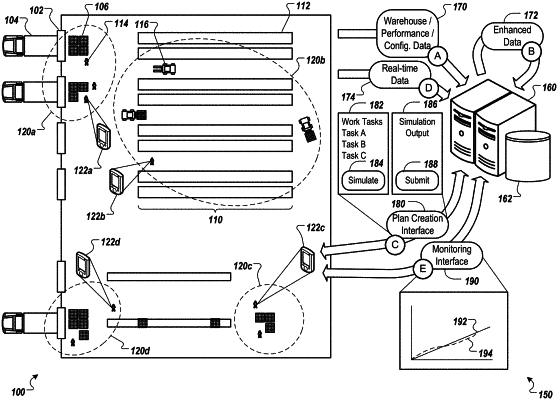| CPC G06Q 10/087 (2013.01) [G06Q 10/06316 (2013.01); G06Q 10/06398 (2013.01)] | 19 Claims |

|
1. A computer-implemented method comprising:
providing, by a warehouse coordination system and to a client device, data for presentation of a plan creation interface for a warehouse process, wherein the plan creation interface presents (i) one or more controls for selecting and sequencing tasks to be performed over a shift for the warehouse process, (ii) one or more controls for applying resources that are available for performing the tasks, and (iii) one or more controls for executing a simulation of the tasks to be performed;
receiving, by the warehouse coordination system and through the plan creation interface presented by the client device, (i) a defined sequence of the tasks to be performed over the shift for the warehouse process, (ii) defined resources to be applied to the tasks, and (iii) a command to execute the simulation of the tasks;
in response to receiving the command to execute the simulation of the tasks, executing, by the warehouse coordination system, the simulation of the tasks to be performed over the shift for the warehouse process, according to the defined sequence of the tasks and the defined resources to be applied to the tasks;
generating, by the warehouse coordination system, simulation output data based on the simulation of the tasks to be performed;
storing, by the warehouse coordination system, data that represents the defined sequence of the tasks to be performed, data that represents the defined resources to be applied to the tasks, and the simulation output data based on the simulation of the tasks to be performed;
receiving, by the warehouse coordination system and from data collection devices in a warehouse environment, real-time warehouse data that indicates the tasks being performed over the shift for the warehouse process;
providing, by the warehouse coordination system and to the client device, data for presentation of a performance monitoring interface for the warehouse process, wherein the performance monitoring interface presents, for each time period of a series of consecutive time periods that occur over the course of the shift, an amount of tasks that have been predicted to be performed according to the simulation of the tasks, in comparison to an amount of tasks that have been performed according to the real-time warehouse data;
receiving, by the warehouse coordination system and through one or more input controls of the performance monitoring interface presented by the client device, data that specifies an event that has occurred during the shift and that has impacted performance of the tasks;
in response to receiving the data that indicates the event that has occurred during the shift, (i) determining, by the warehouse coordination system, that the event is represented in a knowledge base that correlates events with deviations between predicted and actual task performance, (ii) executing an updated simulation of the tasks that are yet to be performed over the remaining portion of the shift, wherein executing the updated simulation includes adjusting a predicted performance of the tasks that are yet to be performed, according to an adjustment factor that is correlated with the event, and (iii) for the remaining portion of the shift, updating the performance monitoring interface to present an updated amount of tasks that have been predicted to be performed according to the updated simulation of the tasks, in comparison to the amount of tasks that have been performed according to the real-time warehouse data; and
after the shift has occurred, updating the knowledge base to include an updated correlation between the event and an updated deviation between predicted and actual task performance, based on data that represents actual task performance relative to predicted task performance over the shift.
|